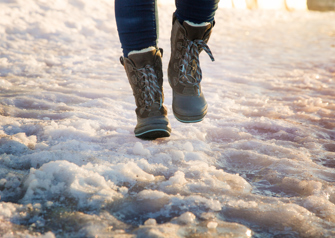
News
Winter Weather: Avoiding Slips and Falls
Date posted: 12/7/2016
Last updated: 1/23/2024
Table of Contents
Icy sidewalks are inevitable during the winter months and falling can be very dangerous. According to the National Safety Council, slips and falls are the single largest cause of emergency room visits - and most of these falls can be attributed to walking on icy surfaces.
THE MOST COMMON FALLING INJURIES:
- Back. Often falling on the ice can cause deep muscle strain in the back.
- Fractures. This includes fractures to the hip, vertebra, forearm, leg, ankle, pelvis and hand.
- Head injury. This can sometimes result in concussions.
- Broken tailbone.
This chilly winter, following are some tips from Midwest Orthopaedics at Rush primary care sports medicine physician, Dr. Nicole Levy, to help prevent falls:
TIPS TO AVOID SLIPS AND FALLS:
- Wear the proper shoes. Shoes with ice and snow traction straps are perfect for the avid outdoor walker. Find shoes containing cleats that attach to the bottom of the shoe for added traction. Avoid wearing dress shoes on actual pavement as they provide less support, which can throw off your center of gravity.
- Try using an assistive walking device. Even if you have never used a cane or walker, these tools can give you some extra stability and help with your balance during the winter.
- Always carry your phone. If you are going for a walk, make sure you have a charged cell phone to contact someone in case of an emergency.
- Walk outdoors in good light. Good vision is key when walking outdoors in the winter. Avoid walking outdoors around dusk or after dark, because it becomes difficult to see ice on sidewalks.
- Use salt on your driveway and sidewalks. Try carrying a small bag of salt with you in case you find yourself on a particularly icy sidewalk. This bag may come in handy if you exit a car in a slippery parking lot. Cat litter is useful too!
- Walk on the grass or snow if the sidewalk is too icy.
- Take small steps on icy areas. Just like when you are first learning to ice skate, you can keep your balance by taking small steps on the ice. Taking too big of steps will cause your foot to slide and you to fall.
- Make sure your hands are free. In order to maintain balance, keep your hands out of your pockets and avoid carrying anything in your hands.
- Avoid running at all costs. Even if you need to make your bus or catch a cab, ice patches are hard to see. This is especially true while your vision is blurred as your run.
- Try to remove snow first. Before you go outdoors, attempt to remove the snow from around your house quickly before it turns to ice. If you wait for the snow to melt, removal could take days.
As always, use your best judgment when deciding if it is safe to go outdoors this winter. These tips can help you avoid slipping and falling on dangerous ice paths and keep you safe this season.
Dr. Levy also recommends limiting your time outdoors to 15 minutes in sub-zero temperatures and wearing at least three layers of protective clothing so you do not expose too much skin to the frigid air.

